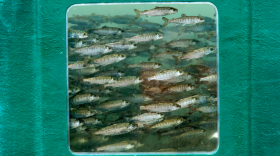Debris from last year’s Japanese tsunami has in fact hit Northwest beaches, according to new modeling by the National Oceanic and Atmospheric Administration, and Washington state is putting up posters to help you decide what to do if you spot any.
The new model by NOAA shows where the debris is, not when the bulk of it will hit the shores. But, as has been reported, some debris has crossed the ocean. Last week, the Coast Guard sank a derelict Japanese fishing vessel off the coast of Southeast Alaska. Also, glass and plastic floats have turned up.
Nevertheless, the new model gave NOAA an understanding of where debris from the tsunami may be located today, because modelers were able to simulate how winds and ocean currents from the past year may have moved items through the Pacific Ocean.
The model below (which you can expand and move around inside the window with your mouse) shows where debris may be now, but it does not predict when debris will reach U.S. shores in the future. It's a "hindcast," rather than a "forecast."
The bulk of the debris is likely still dispersed north of the Main Hawaiian Islands and east of Midway Atoll, NOAA reported on its Website.
Posters going up
The warning posters titled “Japan Tsunami Marine Debris: What to do if you see debris” are going up at beaches around Washington now and will be replaced as they weather or disappear, said Charles Wallace, Deputy Director of Emergency Management for Grays Harbor County.
Here’s what the poster says:
Be safe: If you don’t know what it is, don’t touch it. Collect as much information from a safe distance as you can – including photos – and report the debris to DisasterDebris@noaa.gov. If the item appears unusual or hazardous, contact your local authorities for specific guidance and instructions (see below).
Litter and other typical marine debris items: Common marine debris types will vary by location. If an object can be linked to the tsunami, please report it to DisasterDebris@noaa.gov. Please provide as much information as possible. Where it’s safe and practical to do so, people should remove the debris and recycle any plastics or metals.
Hazardous materials: Drums, fuel tanks and containers, gas cans, gas cylinders, chemical storage totes. Do not touch or attempt to move the item. Give authorities a detailed report about what you’ve observed. Call the National Response Center at 1-800-424-8802 AND 1-800-OILS-911 (1-800-645-7911).
Aluminum Canisters: 10-inch aluminum insecticide canisters often are found in high tide zones. Do not open the cap since these fumigant canisters may contain small amounts of toxic phosphine gas. Call the National Response Center at 1-800-424-8802 AND 1-800-OILS-911 (1-800-645-7911).
Derelict boat or other large debris item: Do not attempt to move or remove the boat. Report it to the U.S. Coast Guard 24-Hour Command Center, 206-217-6001.
Personal effects or possessions from Japan tsunami: Items that appear to be personal belongings should be treated with respect. They should be reported with as much relevant detail as possible. Generally, these objects should be left in place for later retrieval. However, if the object appears likely to be moved by tide or wave action and it is safe to do so, consider moving the object above the high-tide line. Report these to DisasterDebris@noaa.gov.
Human remains: It is extremely unlikely any human remains from the tsunami will reach the United States. However, if you encoun-ter any remains, immediately call 9-1-1 and give local authorities a detailed report about what you observed. Do not touch or attempt to move.
Unknown Item: Don’t touch or attempt to move the item. Give local authorities a detailed report about what you observed.
On the Web:








